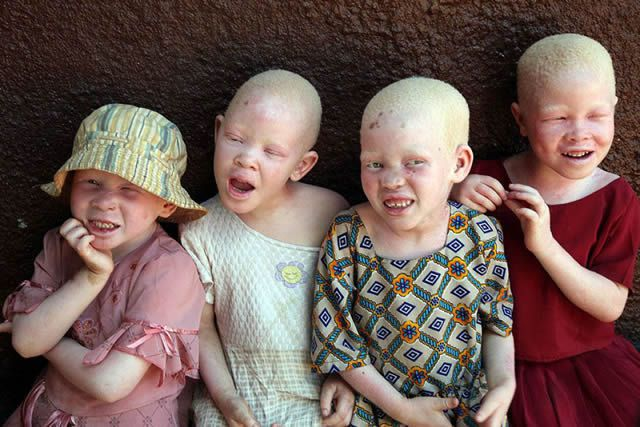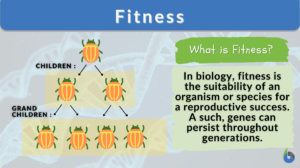
Fitness
n., [ˈfɪtnəs]
Definition: In biology, the condition or attribute of being fit, such as the suitability of an organism or a species to find a mate and reproduce offspring successfully, thus genes may persist throughout generations.
Table of Contents
A competing variant’s frequency is rising in relation to other competing variants in a population under the biological condition known as fitness, or the capacity to carry out a function depending on its appropriateness. Generally speaking, fitness refers to the condition or characteristic of being suitable, such as being in good health as in the case of physical fitness. But here, we will focus on the definition of biological fitness.
Definition of Biological Fitness
Most times when people think of fitness, they think of the ability to be able to do physical work without being exhausted. This is sometimes influenced by an organism’s active nature or its genetic makeup.
What does fitness mean in genetics? Fitness in genetics stems from the definition of fitness in biology.
To define fitness in biology, one must refrain from thinking of the typical fitness that deals with exercise, but rather, the fitness of passing along genetic traits. This is the fitness science definition versus the everyday definition of fitness.
So what is biological fitness? Fitness in biological science definition is the capacity of an organism to pass on its DNA to its progeny is referred to as biological fitness. Fitness refers to the transmission of genes in terms of genotype and phenotype for context. The physical traits — which can range from height to eye color — that are produced by the genes found in the DNA of an organism are called phenotypes. Genotype can be defined as the genetic or biological makeup (DNA) of an organism which is often passed from generation to generation.
It is sufficient to assign genotype fitnesses in asexual reproduction. Allele fitness values can be awarded by averaging over potential genetic backgrounds since sexual reproduction scrambles alleles into distinct genotypes every generation.
Darwinian evolution is the result of natural selection’s tendency to gradually increase the frequency of genes with better fitness. To distinguish between physical fitness and Darwinian fitness, use the term “Darwinian fitness”. Darwinian fitness is sometimes known as Charles quality fitness as well.
Fitness measures many things but does not include a measure of how long an organism will survive or its life span.

Watch this vid about biological fitness:
Fitness refers to the biological condition in which a competing variant is increasing in frequency relative to other competing variants in a population. In general, fitness pertains to the state or quality of being fit, e.g. physically or mentally, as in physical fitness. It means the capability to perform a function based on its suitability. In biology though, “fitness” is more encompassing. It is concerned more with the reproductive capability of an organism and its genetic contribution to the gene pool. Fitness, in the biological context, is also called Darwinian fitness. Darwinian fitness describes how successful an organism has been at passing on its genes.
- The more likely that an individual is able to survive and live longer to reproduce, the higher the fitness of that individual will be.
Thus, it may indicate the relative measure of the reproductive success of an organism in passing its genes to the next generation. It denotes the relative ability of an individual (or population) to survive, reproduce and propagate genes in an environment. Two ways by which fitness can be measured: (1) absolute fitness and (2) relative fitness.
History
In his book Principles of Biology from 1864, British sociologist Herbert Spencer used the phrase “survival of the fittest” to describe what Charles Darwin had dubbed natural selection. This meant that the best forms of the phenotypes and genotypes of certain individual organisms would survive. This supports the theory of natural selection.
Natural selection is best described as the process by which living organism populations adapt and change. This variety depicts that certain characteristics and traits will be better and more adaptable to their environments than many others and so continue throughout generations.
Beginning with his 1924 publication A Mathematical Theory of Natural and Artificial Selection, the British biologist J.B.S. Haldane was the first to quantify fitness in terms of the contemporary evolutionary synthesis of Darwinism and Mendelian genetics. The next development came with the 1964 publication of The Genetical Evolution of Social Conduct by British biologist W.D. Hamilton. He was the one who brought about the idea of inclusive fitness.
What Is Fitness Evolution (Evolutionary Fitness)?
Simply expressed, an organism’s capacity for reproduction and survival is its evolutionary fitness. Reproductive success, or how well a genotype or phenotype is passed down to the next generation in comparison to other genotypes and phenotypes, is used to measure it.
What Causes Fitness Evolution?
Evolutionary fitness is measured by survival fitness and reproductive fitness. These are needed to ensure that maximum fitness and species fitness can be achieved for organisms and their offspring in biology.
- Survival
An organism must endure long enough to mature in order to be able to reproduce. Evolutionary fitness includes survival since an organism’s ability to pass on its genotype or phenotype to following generations depends on its ability to live. Hence, characteristics that help an organism survive can improve its evolutionary fitness. - Reproductive
An organism’s ability to reproduce depends on both its capacity to survive and to attract mates and create children. Because genotypes or phenotypes are handed down through reproduction, reproduction is a factor in evolutionary fitness. So, an organism’s ability to attract mates and create children can help it become more suited for evolution.
Measures of Biological Fitness
The idea of fitness is limited to an asexual population without genetic recombination in order to avoid the difficulties of sex and recombination. As a result, fitnesses may be quantified and directly attributed to genotypes. Absolute fitness and relative fitness are the two most widely utilized fitness metrics.
The proportionate change in a genotype’s abundance throughout a generation attributable to selection is known as the genotype’s absolute fitness (W). Relative fitness (w) determines changes in genotype frequency as opposed to absolute fitness, which controls changes in genotype abundance.
Examples of Biological Fitness
Although its effects can be felt within a subsection of a species, biological fitness is the primary determinant of a species’ ability to persist, as was already mentioned. One such disorder is albinism, which results in a lower degree of fitness in its victims. Albinism does not limit their ability to breed, but it has an impact on them every day. Albinism is characterized by a lack of melanin.

The protein melanin is in charge of giving skin, hair, and eye pigment its color. Due to a lack of melanin, albinos have light pigmentation in their eyes, eyes, skin, and hair, as well as poor vision and skin issues.
Albinos typically limit their exposure to ultraviolet radiation because of their higher risk of developing skin issues (the sun).
The albinism feature, because of genotypes in organism biology, continues to be passed down from generation to generation.
On the other hand, certain species have higher fitness levels than others, which increases their chances of surviving. Fish that live in entirely dark caverns have rudimentary eyes that do not function. The natural selection that kept the fishes’ eyes functioning was no longer in place when their seeing relatives ended up living in caves.
Fish with better vision no longer dominate fish with poorer vision. These fish still have eyes today, but they serve no purpose and are not an adaptation; rather, they are just a legacy of their evolutionary past.

Food for Thought!
Depending on its capacity for adaptation, an organism’s fitness may rise or fall. The ability of the species to pass along or share genetic information with future generations will be compromised if it cannot adapt to environmental changes. This is the reason that many organisms have become extinct or evolved into other species. Can you think of any organisms which became extinct because of their inability to adapt to new environments?
Take the Fitness – Biology Quiz!
References
- Adaptation—Understanding Evolution. (2021, March 24). https://evolution.berkeley.edu/evolution-101/mechanisms-the-processes-of-evolution/adaptation/
- Biological Fitness Definition & Examples | What is Fitness in Biology? – Video & Lesson Transcript. (n.d.). Study.Com. Retrieved February 25, 2023, from https://study.com/learn/lesson/what-is-fitness-in-biology.html
- Charles Darwin – Survival of the Fittest. (n.d.). Retrieved February 28, 2023, from https://mapmygenome.in/blog/charles-darwins-survival-of-the-fittest
- Evolutionary Fitness: Definition, Role & Example | StudySmarter. (n.d.). StudySmarter US. Retrieved February 28, 2023, from https://www.studysmarter.us/explanations/biology/heredity/evolutionary-fitness/
- JUNE, W., & Logos, E.-. (2020, February 28). The international attention in favor of people with Albinism in Africa. Eyes on Europe. https://www.eyes-on-europe.eu/the-international-attention-in-favor-of-people-with-albinism-in-africa/
- Maryland, U. of. (n.d.). Gene found that causes eyes to wither in cavefish. Retrieved February 28, 2023, from https://phys.org/news/2020-06-gene-eyes-wither-cavefish.html
- Natural Selection. (n.d.). Retrieved February 28, 2023, from https://education.nationalgeographic.org/resource/natural-selection/
- Tff.pdf. (n.d.). Retrieved February 28, 2023, from https://web.archive.org/web/20110718075456if_/http://philosophy.wisc.edu/sober/tff.pdf
©BiologyOnline.com. Content provided and moderated by Biology Online Editors.









